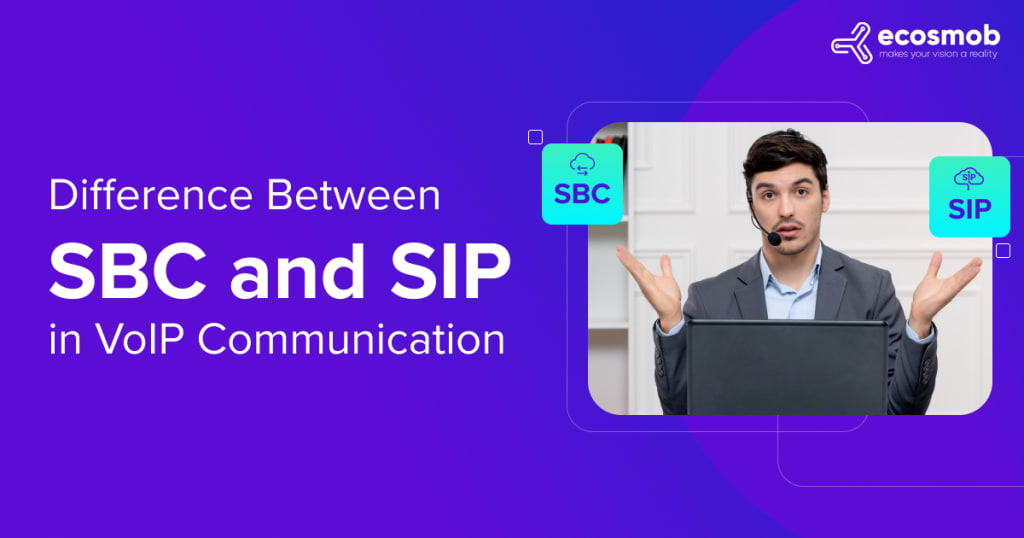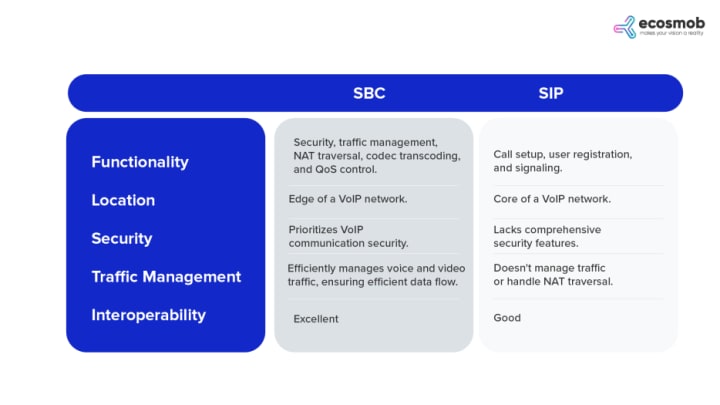Difference Between SBC and SIP in VoIP Communication
Difference Between SBC and SIP in VoIP Communication

In the current age, Voice over Internet Protocol (VoIP) technology has revolutionized how businesses communicate. VoIP enables organizations to make cost-effective voice and video calls over the Internet, and it has become an integral part of modern communication systems.
Two critical components of VoIP are Session Initiation Protocol (SIP) and Session Border Controller (SBC). Understanding the differences between SIP and SBC is crucial for businesses looking to optimize their VoIP infrastructure and enhance communication.
In this blog post, we'll delve into understanding SBC vs. SIP–shedding light on their roles and functionalities.
SIP (Session Initiation Protocol)
SIP serves as a signaling protocol in VoIP networks to establish, manage, and terminate multimedia sessions, such as voice and video calls. It is a standard protocol defined by the Internet Engineering Task Force (IETF) and is pivotal in enabling real-time communication over the Internet.
Key Features of SIP
Call Setup: SIP is primarily responsible for initiating calls. When you make a VoIP call, SIP is the protocol that signals the intent to start a conversation. It negotiates session parameters, such as codecs and endpoints, to ensure both parties can communicate effectively.
User Registration: SIP allows users to register their devices, such as smartphones or IP phones, with a VoIP service provider. This registration process ensures that incoming calls can reach the intended recipient.
Call Transfer and Forwarding: SIP enables features like call transfer and call forwarding, making it easy for users to redirect calls to other devices or colleagues as needed.
Presence Information: SIP can provide information about a user's availability, helping implement presence and instant messaging features.
Interoperability: SIP is designed to work with various protocols and technologies, making it versatile and suitable for different VoIP systems.
SBC (Session Border Controller)
On the other hand, SBC is a critical component in VoIP networks that serves as a firewall and traffic manager for voice and video packets. Session Border Controllers are positioned at the border of a network and act as intermediaries between different networks or domains.
Key Features of SBC
Security: One of the primary roles of an SBC is to enhance the security of VoIP communications. It is a barrier against unauthorized access, protecting the internal network from malicious attacks and fraud.
NAT (Network Address Translation) Traversal: SBCs facilitate NAT traversal, allowing devices behind firewalls or routers to communicate with devices in other networks without issues.
Codec and Protocol Transcoding: SBCs can perform codec and protocol transcoding, ensuring that incompatible devices can communicate by converting media formats or signaling protocols.
Quality of Service (QoS): SBCs can prioritize voice and video traffic, ensuring that critical communication gets the necessary network resources to maintain high call quality.
Interoperability: Like SIP, SBCs are designed to ensure interoperability among different VoIP networks and service providers.
SBC in SIP Trunking
Now, let's step into the world of SIP Trunking, a technology that allows businesses to connect their Private Branch Exchange (PBX) to the internet, enabling voice and data communication. In SIP Trunking, the role of SBC becomes even more critical.
SIP Trunking replaces traditional phone lines with internet-based connections, allowing businesses to make and receive calls over the internet. It offers several advantages, including cost savings, scalability, and flexibility. SIP Trunking enables businesses to consolidate voice and data services, simplifying their communication infrastructure.
And in the context of SBC in SIP Trunking, SBC serves as the ultimate guardian of VoIP security and efficiency.
Key Differences Between SBC and SIP

In Conclusion
In the intricate world of VoIP communication, SIP and SBC are indispensable components, each with distinct roles and responsibilities.
While SIP facilitates initiating and managing VoIP sessions, SBC emerges as the guardian of SIP Trunking, where security and efficiency are paramount. For SIP Trunking, SBC is the cornerstone of secure and efficient communication, enabling businesses to navigate the complex landscape of modern communication confidently.
Understanding the differences between SIP and SBC is essential for businesses looking to enhance their VoIP infrastructure. By harnessing the strengths of both SIP and SBC, organizations can fortify their VoIP networks' security, reliability, and efficiency. This helps in ultimately improving communication with clients, partners, and employees in today's interconnected world.
About the Creator
Enjoyed the story? Support the Creator.
Subscribe for free to receive all their stories in your feed. You could also pledge your support or give them a one-off tip, letting them know you appreciate their work.





Comments
There are no comments for this story
Be the first to respond and start the conversation.